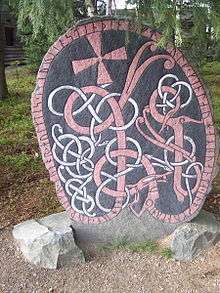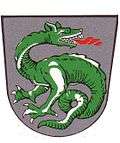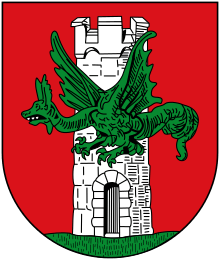Lindworm
 Also known as a "snake" (ormr) or "dragon" (dreki), lindworms were popular motifs on runestones in 11th century Sweden. This runestone is identified as U 871. | |
| Grouping | Cryptid |
|---|---|
| Other name(s) | Lindworm snake, whiteworm |
| Country | Various |
| Region | Northern Europe |
Lindworm (cognate with Old Norse linnormr 'constrictor snake', Norwegian linnorm 'dragon', Swedish, lindorm, Danish, lindorm 'serpent', German Lindwurm 'dragon') in British heraldry, is a technical term for a wingless bipedal dragon often with a venomous bite. In Norwegian heraldry a lindorm is the same as the wyvern in British heraldry. The most famous lindworm is Jörmungandr.
Etymology
In modern Scandinavian languages, the cognate lindorm can refer to any 'serpent' or monstrous snake, but in Norwegian heraldry, it is also a technical term for a 'seaserpent' (sjøorm), although it may also stand for a 'lindworm' in British heraldry.
Generally, the word lindworm stood for the Latin word draco (whence Norse dreki), thus could refer to any draconic creature, from a real life constrictor snake to a legendary dragon. In European mythology and folklore, creatures identified as a 'lindworm' may be winged or wingless, and quadrupedal, bipedal or limbless. However late persistent tradition designates the lindworm as having no limbs, or just front claws (so that it must slither) in contrast to wyverns that have only hind-quarters (and possible claws on the end of its wings) and in contrast to dragons which have four legs and may either be winged or wingless.
Lindworms in tales
In Norse Mythology, the Midgard Serpent is the most prominent of lindworms. In Grímnismál, Odin tells of several lindworms gnawing on Yggdrasil from below, "more than a unlearned fool would know". Odin names these lindworms (using the word "ormr" meaning snake and serpent) as Níðhöggr, Grábakr, Grafvölluðr (meaning he who digs deep beneth), Ofnir, Svafnir, Grafvitni (grave-wolf) and his sons Góinn and Móinn.[1] [2] Grafvitni is used as a kenning for "serpent" in Kraukamál.
Saxo Grammaticus begins his story of Ragnar Loðbrók, a semi-legendary king of Denmark and Sweden, by telling that a certain Þóra Borgarhjörtr receives a baby lindworm as a gift from her father Herrauðr, the Earl of Götaland. As the lindworm grows, it eventually takes Þóra hostage, demanding to be supplied with no less than one ox a day, until she is freed by a young man in fur-trousers named Ragnar, who thus obtains the byname of Loðbrók ("hairy britches") and becomes Þóra's husband.
In many descriptions, the lindworm is wingless, with a poisonous bite, like a poisonous snake or Komodo dragon.
The dragon Fáfnir from the Norse Völsunga saga appears in the German Nibelungenlied as a lindwurm that lived near Worms.

Another German tale from the 13th century tells of a lindworm that lived near Klagenfurt. Flooding threatened travelers along the river, and the presence of a dragon was blamed. The story tells that a Duke offered a reward for anyone who could capture it; so some young men tied a bull to a chain, and when the lindworm swallowed the bull, it was hooked like a fish and killed.[3] The head of a 1590 lindworm statue in Klagenfurt is modeled on the skull of a wooly rhinoceros found in a nearby quarry in 1335. It has been cited as the earliest reconstruction of an extinct animal.[4][5]
The shed skin of a lindworm was believed to greatly increase a person's knowledge about nature and medicine.[6]
A "dragon" with the head of a "salamander" features in the legend of the Lambton Worm, a serpent caught in the River Wear and dropped in a well, which after 3–4 years terrorized the countryside of Durham while the nobleman who caught it was at the Crusades. Upon return, he received spiked armour and instructions to kill the serpent, but thereafter to kill the next living thing he saw. His father arranged that after the lindworm was killed, a hound dog would be released and the son would kill that; but instead of releasing the dog the father ran to his son, and so incurred a malediction by the son's refusal of patricide. Bram Stoker used this legend in his short story Lair of the White Worm.

(wingless bipedal dragon) in British heraldry
The sighting of a "whiteworm" once was thought to be an exceptional sign of good luck.[6]
The knucker or the Tatzelwurm is a wingless biped, and often identified as a lindworm. In legends, lindworms are often very large and eat cattle and bodies, sometimes invading churchyards and eating the dead from cemeteries.
In the 19th-century tale of "Prince Lindworm" (also "King Lindworm"), from Scandinavian folklore, a "half-man half-snake" lindworm is born, as one of twins, to a queen, who, in an effort to overcome her childless situation, has followed the advice of an old crone, who tells her to eat two onions. She did not peel the first onion, causing the first twin to be a lindworm. The second twin is perfect in every way. When he grows up and sets off to find a bride, the lindworm insists that a bride be found for him before his younger brother can marry. Because none of the chosen maidens are pleased by him, he eats each until a shepherd's daughter who spoke to the same crone is brought to marry him, wearing every dress she owns. The lindworm tells her to take off her dress, but she insists he shed a skin for each dress she removes. Eventually his human form is revealed beneath the last skin. Some versions of the story omit the lindworm's twin, and the gender of the soothsayer varies. A similar tale occurs in C.S. Lewis' novel The Voyage of the Dawn Treader.
Late belief in lindorm in Sweden

The belief in the reality of a lindorm, a giant limbless serpent, persisted well into the 19th century in some parts. The Swedish folklorist Gunnar Olof Hyltén-Cavallius collected in the mid 19th century stories of legendary creatures in Sweden. He met several people in Småland, Sweden that said they had encountered giant snakes, sometimes equipped with a long mane. He gathered around 50 eyewitness reports, and in 1884 he set up a big reward for a captured specimen, dead or alive.[7] Hyltén-Cavallius was ridiculed by Swedish scholars, and since nobody ever managed to claim the reward it resulted in a cryptozoological defeat. Rumours about lindworms as actual animals in Småland rapidly died out (Sjögren, 1980).
See also
References
- ↑ http://runeberg.org/salmonsen/2/10/0092.html
- ↑ http://runeberg.org/eddan/se-04.html
- ↑ J. Rappold, Sagen aus Kärnten (1887).
- ↑ Mayor, Adrienne (2000). The first fossil hunters: paleontology in Greek and Roman times. Princeton, N.J: Princeton University Press. ISBN 0-691-08977-9.
- ↑ Proceedings of the Linnean Society of London (Academic Press). 147-148. 1887. Missing or empty
|title=(help) - 1 2 Lindorm, Nordisk Familjebok
- ↑ G.O. Hyltén-Cavallius, Om draken eller lindormen, mémoire till k. Vetenskaps-akademien, 1884.
- Sjögren, Bengt, Berömda vidunder, Settern, 1980, ISBN 91-7586-023-6 (Swedish)
External links
- King Lindorm, translated from: Grundtvig, Sven, Gamle danske Minder i Folkemunde (Copenhagen, 1854—1861).
- Gesta Danorum, Book 9 by Saxo Grammaticus.
- A retelling of Ragnar Lodbrok's story from Teutonic Myth and Legend by Donald Mackenzie.
- Saint George Legends from Germany and Poland
- Lindorm, an article from Nordisk Familjebok (1904–1926), a Swedish encyclopedia now in the Public Domain.
- Lindormen, a ballad in Swedish published at the Mutopia project.
| ||||||||||||||||||||||